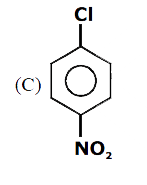Which of most reactive towards nucleophilic aromatic substitution.




The correct Answer is:B
Step by step video, text & image solution for Which of most reactive towards nucleophilic aromatic substitution. by Chemistry experts to help you in doubts & scoring excellent marks in Class 12 exams.
Related Playlists
- BOOK - MOTIONCHAPTER - AROMATIC COMPOUNDEXERCISE - Exercise - 317videos
AROMATIC COMPOUND
- BOOK - MOTIONCHAPTER - AROMATIC COMPOUNDEXERCISE - Exercise - 4 | Level-I13videos
AROMATIC COMPOUND
- BOOK - MOTIONCHAPTER - AROMATIC COMPOUNDEXERCISE - Exercise - 2 (Level-I)47videos
AROMATIC COMPOUND
- BOOK - MOTIONCHAPTER - ALKYI HALIDEEXERCISE - Exercise - 4 | Level-II8videos
ALKYI HALIDE
- BOOK - MOTIONCHAPTER - ATOMIC STRUCTURE EXERCISE - EXERCISE-4 (LEVEL-II)18videos
ATOMIC STRUCTURE
Similar Questions
Which of the following 2-halo nitrobenzene is most reactive towards nucleophilic aromatic substitution ?
View SolutionMost reactive towards SN-Ar (Nucleophilic Aromatic Substitution)
View SolutionWhich of the following is the most reactive towards eklectrophilic aromatic substitution?
View SolutionWhich of the following is most reactive towards electrophillic aromatic substitution for halogen ?
View SolutionWhich of the following compounds is most reactive towards nucleophilic acyl substitution :-
View SolutionWhich of the following compound is most reactive in the nucleophilic aromatic substitution reaction with NaOH ?
View SolutionWhich is least reactive towards nucleophilic substitution (SN2)
View SolutionWhich of the following is most reactive toward nucleophilic substitution reaction ?
View SolutionWhich is least reactive towards nucleophilic substitution (SN2)
View SolutionArrange the following in decreasing order of reactivity towards EAS (electrophilic aromatic substitution)
(a) View Solution
View Solution


